How is black raspberry different from blackberry?

Blackberries and black raspberries are not the same thing as many people think. The berries are really very similar, but they also have significant differences. Something they have in common for sure: tasty, healthy, with high decorative qualities and relatively easy to care for. They can be planted in one area if the choice is difficult and you want to grow everything, but only without the neighborhood. Such similar ones as sisters, yet blackberries and black raspberries do not get along side by side.
How to tell by a bush?
How exactly the bush will look depends not on the species, but on the variety. For example, at the cultivar "Cumberland" (black raspberry) bush is powerful and spreading. But the "Bristol" will reach 3 m in height, so it will have to be tied up.
Sprawling bush and variety «Turn", it has thick thorns, and therefore tying up the plant, and then harvesting - those are still tasks. The bush can grow up to 2.6 m. Black raspberry "Good luck" will grow up to 2 m, but this variety has very few thorns, which means that summer residents prefer it to many other "brothers".
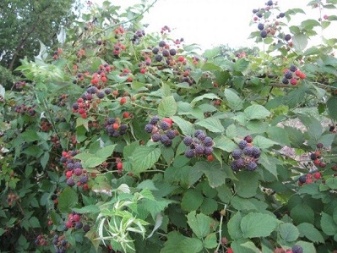
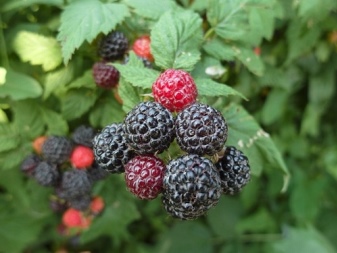
And yet, what do black raspberry bushes have in common:
- the stems of the plant have a falling appearance, a green-gray tint, by winter the color changes to a stable brown;
- leaves are ovoid in shape;
- flowers are collected in a brush;
- oblong petals;
- first, the fruits of raspberries are green, then they, when ripe, turn red and already ripe completely acquire a black color.
Blackberries are similar to raspberries in that the shape of the bush and its features are also determined by the variety. So, "Black Satin" will be an upright, two-meter (maximum) bush. Strong and strong shoots of the blackberry variety "Agavam" already reach a height of 3 m and they will have to be covered for the winter. The "Ruben" variety is frost-resistant, it is erect, does not require support, it is a favorite of many gardeners. The popular variety "Navajo" is good because the plant does not have thorns, and the two-meter height is convenient in the process of caring for the bush.
What do different varieties of blackberry bushes have in common:
- high similarity with raspberries;
- erect form of shoots, sometimes semi-lying;
- long shoots;
- all wild species with thorns;
- denser bush;
- when worn, the color of the stems does not change - they are dark green and remain.
It seems that the description of the bushes alone is still not enough to clearly understand the difference. We'll have to "break" the culture into parts, because the differences are both detailed and not only external.
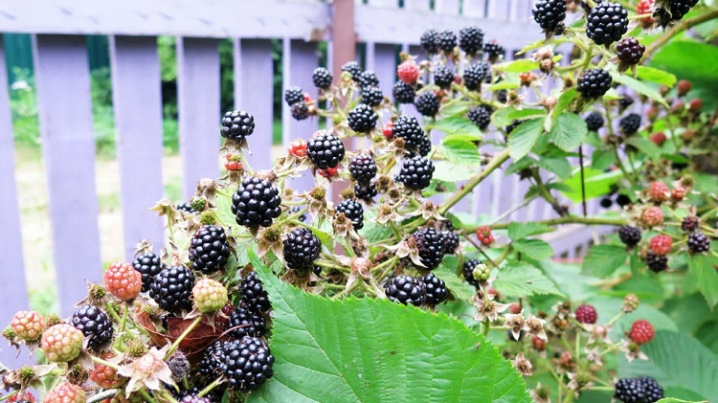
Differences in thorns
Sharp branches are common to both species, because thorns make them so. Only selectively bred blackberry varieties turn out smooth, without thorns. Sharp outgrowths of black raspberries are almost identical to those growing on the more common red raspberries. The branches are covered with thorns very densely, which makes them visually fleecy.
Blackberries have larger thorns than raspberries. And in shape they are curved, almost one in one with those that the rose has. They are thicker and sharper, in a word, they seem much more dangerous than raspberry thorns. And, finally, the effect of hairiness is not created, since the branches are not very densely dotted.
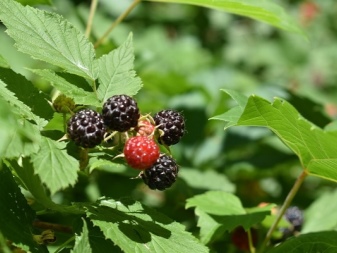

The difference in fruiting
For blackberries, this period is more extended and lasts an average of a month and a half. Wild varieties used to start bearing fruit as soon as summer crossed the equator, but breeders managed to develop varieties that bear fruit at different times. This was done at the request of gardeners, which means that new varieties have become in demand. For example, at the beginning of June, almost at the very start of summer, Natchez and Columbia Star will be harvested.In July it will be possible to enjoy the LochNess and Loughton varieties. And who wants to enjoy berries at the end of summer, having also captured September, should pay attention to the varieties "Smutstem", "Triple Crown".
There are also options with raspberries. For example, at the beginning of summer they will delight with Cumberland and Boysenberry berries. Ugolyok and Luck are popular mid-season varieties of black raspberries, and Bristol yields in late summer. That is, according to this indicator, the berries are almost the same. And the main plus of this variability in ripening time is that you can arrange full-season fruiting on one site: select varieties so that the berries ripen throughout the season (from June to September).
Of course, if the area of the site allows it, and if the owners are ready to "service" the bushes every month.
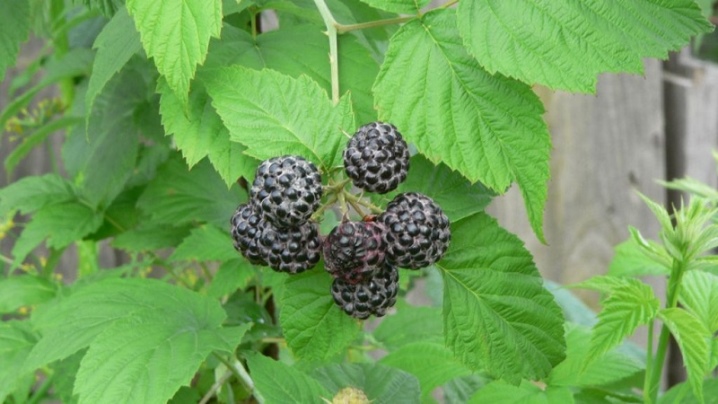
Other differences
Black raspberry is a perennial with a two-year growing cycle. In the first year, shoots will grow, in the second they will harvest. Annual shoots will be thin, branched, with a noticeable bluish bloom, with noticeably hanging tops. Two-year-olds are already getting stiff, turning brown, bloom can be purple, and numerous thorns appear on the shoots. The root system of black raspberry goes deep, it is quite developed. There is no root growth (as happens with red raspberries), which means that reproduction is carried out by layering, and also by rooting the tops. The bush itself is compact, the lashes are up to 3 m, have the shape of an arch, they will have to be cut. Many varieties of black berries are resistant to cold, get sick a little, and are almost not afraid of dangerous insects.
Garden blackberries are also perennials and also have a two-year growing season. But the cycle of the latter can be one-year when it comes to remontant varieties. The forms of blackberry bushes are different: erect, creeping, and even semi-creeping. The shoots are very long and flexible, therefore they also often require pruning.
In most varieties, the whips are expressively thorny, and only hybrids are distinguished by the absence of thorns.

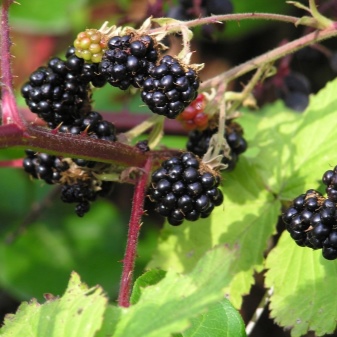
Ripening period
Blackberries have a longer vegetation period than black raspberries. Early varieties will ripen for about a month and a half. In the late, this period can extend to 2 months. Interestingly, on the same branch, berries can ripen at different times. And this lengthens the harvest time, that is, it will be possible to feast on blackberries for a relatively long time.
Raspberries are distinguished by their high resistance to cold, which is equal to the fact that they will ripen faster. The first crop is often harvested in June. It would seem that in this respect, black raspberries are more profitable. But remontant varieties of this type yield only once a year (according to the classical scheme), but blackberries are sometimes harvested until the first frost. For those who prioritize fresh berries rather than preservation, this length of the harvest season is extremely important.
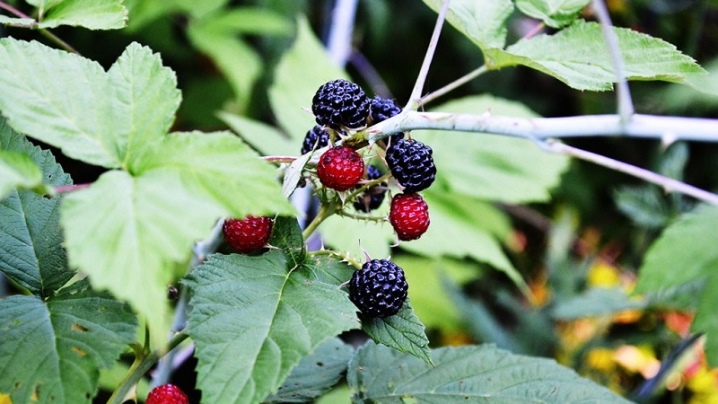
Fruit appearance
Raspberry is more rounded, its shape is rather hemispherical. Garden blackberries will be more oblong, very similar in this sense to red raspberries. Black raspberries have a hollow core, blackberries don't. If you remove raspberries from a bush, a receptacle remains. The blackberry will come off immediately with the stalk.
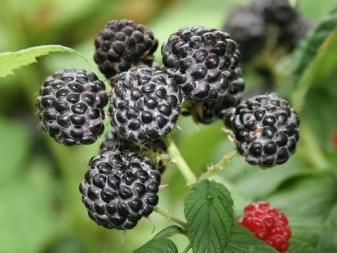
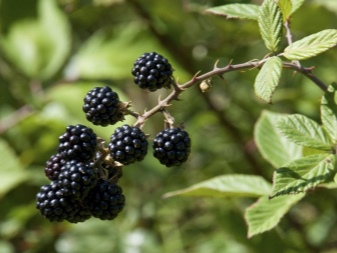
Taste
Black raspberries do without that characteristic sourness for which blackberries are so loved. Raspberries are sweet, and this flavoring accent comes to the fore, whatever one may say. In terms of juiciness and consistency, black raspberries are closer to red varieties. Certain types of blackberries have a pronounced spicy flavor. Therefore, this berry can be added to unusual salads, which should amaze with the multi-layered taste.
Both berries are fine for classic fruit salads. They are used to decorate desserts, ice cream, for example. They are added to yoghurts and milk. And, of course, in one dish you can combine both berries, although in the area of such a neighborhood of berries will not work.
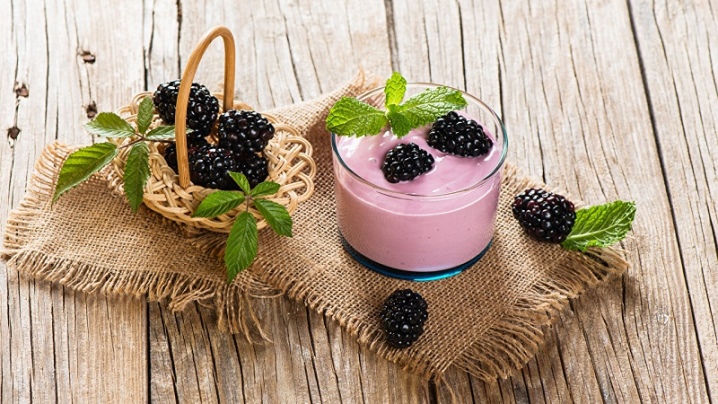
Care
And although family ties are obvious between plants, they really get along badly with each other.You cannot plant them nearby, it will be a failure in any case. That is, on one site, of course, it is possible, but in the neighborhood - not. And these bushes are not even planted one after another. With what you can not settle black raspberries and blackberries: with other varieties of raspberries, eggplants, tomatoes, potatoes. This is a taboo for both types of berries.
We will learn how to care for blackberries and raspberries.
- Blackberries are relatively unpretentious, they love moisture, but they will endure some lack of watering (but if black raspberries are left without moisture, they will quickly die).
- Raspberries will calmly grow and develop in the shade, blackberries will not tolerate this.
- Raspberries tolerate frost well, which cannot be said about blackberries. The berry must be covered for the winter. Raspberries, on the other hand, are not intimidated by a drop in temperature down to -25 ° C.
- Both plants have good immunity, but still they are not "immortal". If they suffer from anything, it is from the fungus. They can be attacked by septoria, powdery mildew, white rot. Of the pests, aphids, beetles, ticks and a bear are especially dangerous for plants.
The requirements for care are simple: preventive work against diseases and pests, timely pruning, watering, harvesting, sheltering for the winter if necessary, mulching, tying branches, as well as a clear understanding of acceptable / unacceptable neighborhood.


Reproduction
In this, the cultures are as similar as possible. The seeds can be bought at the store, or you can collect them yourself from the ripe berries (by first drying them). You can also use the method of dividing the bush, which is carried out in autumn or spring. But the old bushes do not divide - it would be a pointless procedure. To propagate plants by layering, climbing varieties are chosen, they are laid in the ground.
The method of propagation by young root suckers is also suitable: in the springtime they are separated from the common root, transplanted. The sleeping kidney method is also fine. It is necessary to cut off shoots with three buds from the bush in the fall. For the winter, they are sent to the refrigerator or to the basement. At the end of February, they take it out and put it in the water with the kidneys.
Cuttings are also used using green or stem cuttings.













The comment was sent successfully.